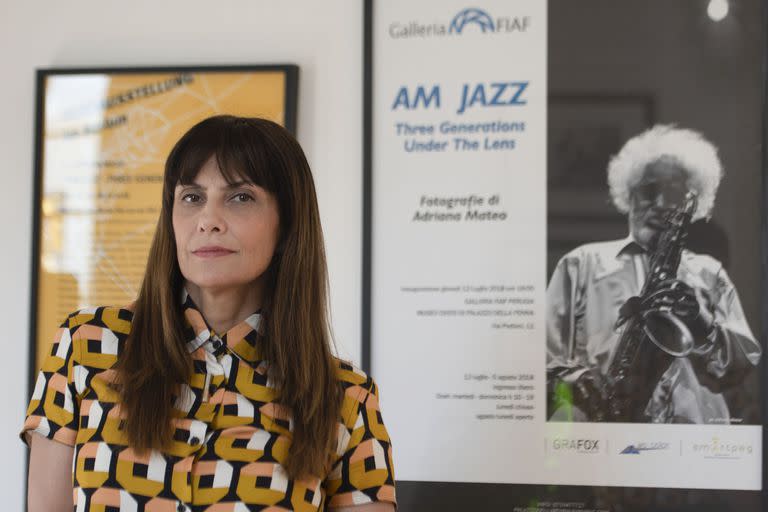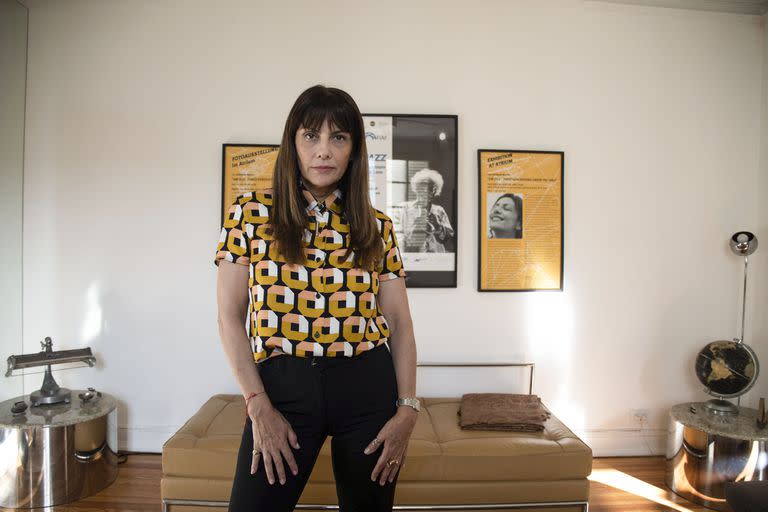Adriana Matthew was born in Buenos Aires. He begins with his father Roberto Mateo, with whom he takes his first steps in photography but also deals with feature films and advertising products. In 1990 he moved to New York, obtained a master’s degree in directing and cinematography at the university of that city and continued his training with great masters. Thanks to his enthusiasm and his love for music, he gradually became a the jazz photographer and today there are many musicians who practically have it in their staff to accompany them on concert tours and festivals, in recordings and in promotional photos. This has led her to be a constant protagonist on stages around the world, to have her photos hung in very important museums, to photograph practically all the most important jazz players in the United States – it would be impossible to name them all – and the production and publication of a book he called “AM JAZZ. Three generations under the lens”. This time Adriana is in her country for family reasons and also to show in full and for the first time her collection of photos on trumpeter and flugelhornist Roy Hargrove, who died prematurely in 2018 and who was her personal photographer.
“This sample is the result of a sum of favorable coincidences, the timing as we would say in New York. I was in Buenos Aires, where I am spending much more time due to my mother’s health problems, I went to the Bebop Club to take some pictures, there I met its owner, Aldo Graziani and its programmer, Karina Nisinman And it ended an incredible coincidence By chance we discovered that Aldo and I are neighbors in a building in Palermo where I bought an apartment a few years ago, but which I only recently started to occupy. So we shared a meal, we talked, I told him about my road show and my book, he told me about his admiration for Roy Hargrove and he discovered that I was his personal photographer. Roy would have turned 53 on October 16 and November 2 was the 4th anniversary of his death. It all ended up in the decision, plus the shared enthusiasm, to make a show exclusively about him. Instead, it will be the first of its kind in the world and, after having exhibited in many places, it will be my first exhibition in my country. And it’s already hanging on the walls of Bebop.”

-What characteristics does the sample have?
-There are three photos of 1 meter by 1.70 and eight of 1 meter by 0.70. And there will also be a very large one, 3 by 2 meters at the back of the room. The initial idea was a little less ambitious, but it grew and we ended up deciding to make very large copies, glued with easy fiber, without glass or acrylic, in the modern style used in Europe. The copies were made in Buenos Aires with very good quality, in an incredible place that fortunately had a stock of imported paper and, for lack of some resources, paid much more attention to it.
-Why did you focus so much on jazz in your career as a photographer?
-When I was 13 or 14 I went with my father, who was his director of photography and lighting, to an Elis Regina show in Brazil. I saw her leave, my dad followed her with a light and I said, “I’m going to do this.” He asked me if I would sing and we laughed because my comment didn’t go there. My dad had a connection to bossa nova, but a lot of jazz was also played at home, so I feel like that’s where I started. Later, when I moved to New York where I did my master’s degree, I started looking for a subject to make a documentary. After the lessons I went to a couple of jazz clubs and I started getting to know all the musicians, the great masters or those of my own generation: Roy Hargrove, Beny Green, Christian McBride and many others. In doing so, I was there living with three generations of musicians. I talked to all of them, I also created personal relationships and I started to reflect on this project of working on the three generations of jazz. Over time, with a lot of work, which ended up leading to my traveling show – which was seen in these parts, nearby, at the Punta del Este jazz festival – and in the book “AM JAZZ. Three generations under the lens”. At this point I’m working on expanding that sample to four generations and we will definitely expand the book as well, or maybe it will end up being a second volume. But to sum up and to better answer your question, I think I fell in love with the nature of jazz, or fell in love again after getting to know all these people better.
-What is the particular bond with Roy Hargrove?
-A very close friendship was born with Roy. When I first started working with him it wasn’t that easy because he was on a lot of tours. He’s someone I admired and loved a lot, I studied a lot about him and it goes without saying what a great musician he was. That’s why I’m happy that my first exhibition in Argentina is also Roy’s first in the world, and that it includes the first and last photos I took of him.
-How much professional aspect and how much fan listener does your work have, in the moment of taking the images and then in the result that reaches a book or an exhibition?
-I’m always in the band, I feel like an extra member. Music enters my ear, produces an aesthetic emotion in me, it is a trance. That’s why I’m a still photographer. I know in advance what they will play, because in many cases I have also heard them many times. I know what a solo is, whether someone is playing good or bad that day. And when I can capture that emotion of the moment is when the photo has sound. And contrary to what one might think, with so many amateur photos, in my opinion it has become much more evident than ever when a photo is professional and is taken by someone who knows the subject. I can’t photograph something I don’t like, and since I always work with great musicians that I admire, I don’t remember what happened to me in live concerts.

-Roll photo or digital photo. What advantages and what disadvantages do you find?
-Of course, the change has changed things a lot. And I think the transition to digital has many positive aspects, especially for the night part. The lights that began to be put on stages in the 90s, with many colors, complicated the task with the chemical chamber. There was a period of vacuum and when digital came out it got a lot better and today the way professional cameras capture light is amazing. That’s not to say, however, that the camera does the work for you; there is always the hand of the professional or, better still, the good professional. And for me, who move in that space between the artistic and the documentary, digital has been a very important step.
-What then happens with the computer edition in your way of working?
-In general, I would tell you that photos can be cropped but they shouldn’t be retouched. For a good photo to have a place in a good exhibit, for it to be printed at the size of this sample of Roy’s, it has to be out there. While editing you can turn down the brightness or contrast a bit, but not much more. I learned to work with the American photographer Ansel Adams’ system, which my father taught me. He created the whites and grays after taking the photos in the tray with the chemicals. But Adams had a photographic mechanism to be able to make that montage. When I take pictures today, or when I teach photography, I already do it with the camera set at a certain speed, at a certain color temperature. So when I have to edit, almost everything I wanted to achieve is already there. Then, as I said, there could be very small adjustments.
Adriana Mateo’s photography. A look at Roy Hargrove. From Tuesday to Sunday, from 19:00 to 28 February. In Bebop, Uriarte 1658. Free admission


